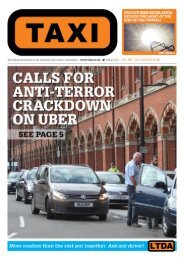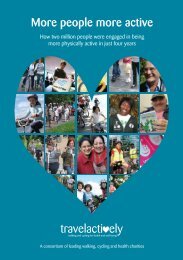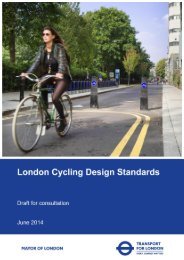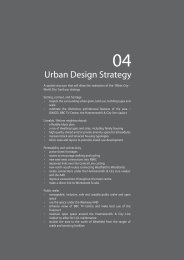Travel in London Travel in London
travel-in-london-report-8
travel-in-london-report-8
Create successful ePaper yourself
Turn your PDF publications into a flip-book with our unique Google optimized e-Paper software.
Overview<br />
• With<strong>in</strong> the overall context of grow<strong>in</strong>g absolute levels of demand, and while per<br />
capita trip rates on weekdays have decl<strong>in</strong>ed slightly over the period of the<br />
survey, per capita weekend trip rates have rema<strong>in</strong>ed relatively stable, with<br />
overall trip rates <strong>in</strong> 2014/15 almost the same as <strong>in</strong> 2005/06. With<strong>in</strong> this stable<br />
trend, however, there has been a decrease <strong>in</strong> shopp<strong>in</strong>g and personal bus<strong>in</strong>ess<br />
trips and a correspond<strong>in</strong>g <strong>in</strong>crease <strong>in</strong> leisure trips at weekends.<br />
• The mode share of trips made at the weekend also differs from trips made on<br />
weekdays. More than 30 per cent of weekday trips by <strong>London</strong> residents are<br />
made us<strong>in</strong>g public transport, which falls to around 24 per cent at weekends.<br />
Almost half of all trips at the weekend are by private transport modes, with a<br />
much larger share of car passenger trips. Cycl<strong>in</strong>g tends to be more common on<br />
weekdays, reflect<strong>in</strong>g the high share of commute trips on that particular mode.<br />
• Trips at weekends have a very different time profile to weekday trips. In contrast<br />
to weekdays, trips at the weekend have one ma<strong>in</strong> peak <strong>in</strong> the middle of the day,<br />
with this peak be<strong>in</strong>g more pronounced on Sundays (between 12:00 and 13:00),<br />
and more spread out across the afternoon on Saturdays, with the peak runn<strong>in</strong>g<br />
from 10:00 to 16:00. However, average trip lengths are remarkably similar on<br />
weekdays and weekends.<br />
What has been driv<strong>in</strong>g the net change <strong>in</strong> mode share towards public transport,<br />
walk<strong>in</strong>g and cycl<strong>in</strong>g for travel <strong>in</strong> <strong>London</strong>?<br />
• Between 1994 and 2014 there has been a net shift <strong>in</strong> mode share, at the trip<br />
level, of 13 percentage po<strong>in</strong>ts away from the private car towards public<br />
transport, walk<strong>in</strong>g and cycl<strong>in</strong>g. This shift relates to all travel <strong>in</strong> <strong>London</strong>, whether<br />
by residents or non-residents. The equivalent shift over the period of the LTDS<br />
survey from 2005 to 2014 was 6.5 percentage po<strong>in</strong>ts (all trips <strong>in</strong> <strong>London</strong>).<br />
• Look<strong>in</strong>g only at <strong>London</strong> residents, a similar pattern of modal shift has been seen<br />
<strong>in</strong> the 10 years that LTDS has been runn<strong>in</strong>g. Among <strong>London</strong> residents, there was<br />
a net modal shift from private to public transport of 5 percentage po<strong>in</strong>ts, with<br />
the public transport mode share ris<strong>in</strong>g from 26 per cent <strong>in</strong> 2005/06 to 31 per<br />
cent <strong>in</strong> 2014/15, and a correspond<strong>in</strong>g decrease <strong>in</strong> private transport mode share<br />
from 42 per cent to 36 per cent. While this overall trend of modal shift is<br />
representative of chang<strong>in</strong>g travel patterns among <strong>London</strong> residents considered<br />
as a whole, there have been differ<strong>in</strong>g trends among different social groups and <strong>in</strong><br />
different locations.<br />
• There has been a susta<strong>in</strong>ed decl<strong>in</strong>e <strong>in</strong> private transport mode share among <strong>in</strong>ner<br />
<strong>London</strong> residents, from 27 per cent <strong>in</strong> 2005/06 to 20 per cent <strong>in</strong> 2014/15. The<br />
<strong>in</strong>crease <strong>in</strong> public transport mode share over this period was relatively small,<br />
mov<strong>in</strong>g from 37 to 38 per cent. Among <strong>in</strong>ner <strong>London</strong>ers, more of the modal<br />
shift away from private transport <strong>in</strong> the last 10 years has been towards cycl<strong>in</strong>g,<br />
with a 2 percentage po<strong>in</strong>t <strong>in</strong>crease <strong>in</strong> mode share, and walk<strong>in</strong>g, which has seen a<br />
3 percentage po<strong>in</strong>t <strong>in</strong>crease.<br />
• Outer <strong>London</strong> residents’ private transport mode share also decreased between<br />
2005/06 and 2014/15, but by a comparatively small 4 percentage po<strong>in</strong>ts. The<br />
<strong>in</strong>crease <strong>in</strong> public transport mode share among outer <strong>London</strong>ers, however, was<br />
much greater than that <strong>in</strong> <strong>in</strong>ner <strong>London</strong>, at 6 percentage po<strong>in</strong>ts. Cycl<strong>in</strong>g too saw<br />
an <strong>in</strong>crease <strong>in</strong> mode share among outer <strong>London</strong>ers, of 1 percentage po<strong>in</strong>t, but<br />
the mode share of walk trips decl<strong>in</strong>ed by 4 percentage po<strong>in</strong>ts over 10 years.<br />
19 <strong>Travel</strong> <strong>in</strong> <strong>London</strong>, Report 8








